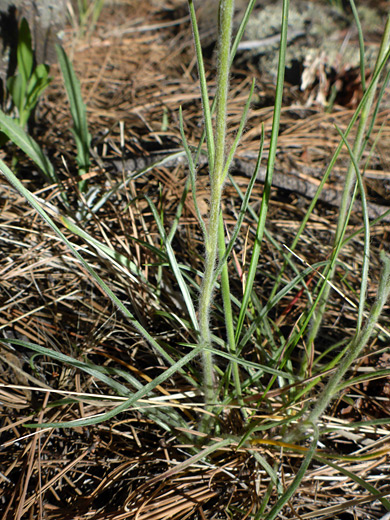Common name:
Bigelow's rubberweed
Family:
Scientific name:
Hymenoxys bigelovii
Main flower color:
Range:
Arizona, west New Mexico and far southeast Utah
Height:
Up to 2 feet
Habitat:
Forest margins, roadsides, from 4,300 to 8,200 feet
Leaves:
Narrow, linear, usually unlobed; up to 3 inches long
Season:
May to June
Hymenoxys bigelovii, a perennial, produces from one to five stems, green or purplish, with a fairly uniform covering of spreading white hairs of differing lengths. The narrow leaves are also hairy, sometimes sparsely so, and may be somewhat glandular. Both basal and cauline leaves are usually undivided, but sometimes three-lobed at the tip.
Each stem is usually topped by a single flowerhead, occasionally by a small cluster. The broad, bell-shaped involucre is lined by two rows of phyllaries, narrowly lanceolate to oblanceolate in shape, 13 to 19 in each series. The outer phyllaries are joined only around the base, at most to one fifth of their length. Phyllaries are topped by a short bristle. The yellow ray florets number between 13 and 15, disc florets to 250 or more.
Each stem is usually topped by a single flowerhead, occasionally by a small cluster. The broad, bell-shaped involucre is lined by two rows of phyllaries, narrowly lanceolate to oblanceolate in shape, 13 to 19 in each series. The outer phyllaries are joined only around the base, at most to one fifth of their length. Phyllaries are topped by a short bristle. The yellow ray florets number between 13 and 15, disc florets to 250 or more.
All Contents © Copyright The American Southwest | Comments and Questions | Contribute | Site Map



